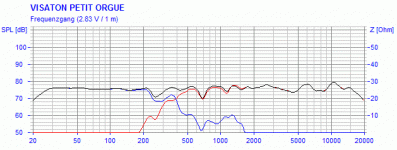I think my wife is on the camp of "the smaller the baffle, the better". She liked the baffleless better. So thinking of narrowing the MTM baffle as much as possible and trimming the 18" baffle on the top of the driver to match the MTM panel and try to get away with keeping the bottom panel below the 18". But need to measure so to know how much difference it makes...it might not be a battle worth fighting and just go baffleless on the 18" 🙂
maybe you can place 18" in ripole, it will be narrow from the front, not much wider than MTM, wife may like it...
maybe you can place 18" in ripole, it will be narrow from the front, not much wider than MTM, wife may like it...
Hello Adason!
I haven't looked into ripoles. My limited understanding is that they are made of two woofers facing each other, attached from their frames, and their axis perpendicular to the listening position. Is that right?
My 18" are 8" deep, so two facing each other plus about 4" space in between would be 20" wide which would be wider that the 18" facing the listening position.
How high in frequency are ripoles recommended to go?
Thank you!
This kind of topic (Ripole with large driver) came up in another thread recently. See my reply here:
Ripole with 15" woofers
The upper frequency of the Ripole is limited by the self-resonance of the cavity or tunnel that forms the Ripole. The deeper the cavity, the lower the resonance frequency, and the higher the aspect ratio (ratio of depth to cross sectional area) the higher the Q of the resonance.
Ripole with 15" woofers
The upper frequency of the Ripole is limited by the self-resonance of the cavity or tunnel that forms the Ripole. The deeper the cavity, the lower the resonance frequency, and the higher the aspect ratio (ratio of depth to cross sectional area) the higher the Q of the resonance.
may be I was not completely clear, I mean one 18" woofer placed sideways, on Z or N (whatever you want to call it) baffle
I mean ripole like, but with one woofer
similarly here, on SL web page, but narrow
Dipole Woofer
I mean ripole like, but with one woofer
similarly here, on SL web page, but narrow
Dipole Woofer
I was able to measure the MTM outside today. It was very windy so had let go of the intent to measure it atop the swinging 18" and placed the MTM directly on the measurement rotating table. Mic was placed at the center of the tweeter, mic at 1.6m from floor, 1m away from baffle. I expect a refection from the bottom 8" to the table, but it's a compromise I had to live with to get it measured today.
The MTM assembly was on the table and I connected/disconnected the driver I wanted to measure. TPL was installed but not connected.
Top driver playing alone:

Bottom driver playing alone:
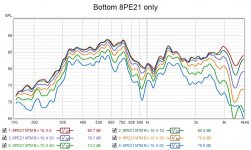
Both playing together full range:
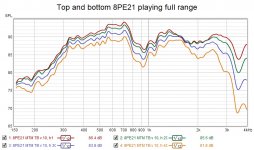
There is clearly something happening between 700 and 1300Hz. Probably a mix of driver characteristics (as seen in my Nov measurement of the naked driver) plus the effect of the baffle itself. But is interesting that when both drivers play together the trough at 935Hz it's at the same SPL that at where they reach at 290Hz. Since I will be digitally correcting the response, it seems 300Hz xo is a safe bet.
I guess an option is to run both 8" from 300 to 1500Hz, but the risk is lobbing around 1500Hz. So the inductor in between them would mitigate that. Looking at top, bottom and both drivers response:
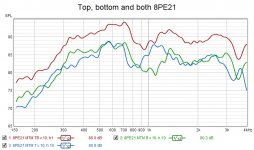
The trough at 935Hz kind of kills my previous idea of taking the bottom 8" out with an inductor by 700Hz or so. Should I target 1kHz?
Later in the afternoon the wind really picked up and had to call it a day without measuring the 18".
Would love to get your thoughts.
The MTM assembly was on the table and I connected/disconnected the driver I wanted to measure. TPL was installed but not connected.
Top driver playing alone:

Bottom driver playing alone:

Both playing together full range:

There is clearly something happening between 700 and 1300Hz. Probably a mix of driver characteristics (as seen in my Nov measurement of the naked driver) plus the effect of the baffle itself. But is interesting that when both drivers play together the trough at 935Hz it's at the same SPL that at where they reach at 290Hz. Since I will be digitally correcting the response, it seems 300Hz xo is a safe bet.
I guess an option is to run both 8" from 300 to 1500Hz, but the risk is lobbing around 1500Hz. So the inductor in between them would mitigate that. Looking at top, bottom and both drivers response:

The trough at 935Hz kind of kills my previous idea of taking the bottom 8" out with an inductor by 700Hz or so. Should I target 1kHz?
Later in the afternoon the wind really picked up and had to call it a day without measuring the 18".
Would love to get your thoughts.
may be I was not completely clear, I mean one 18" woofer placed sideways, on Z or N (whatever you want to call it) baffle
I mean ripole like, but with one woofer
similarly here, on SL web page, but narrow
Dipole Woofer
Got it! I need to look into it.
Thank you!!
That 10db null would bug me. Should figure out what's causing it as your Nov measurement of this driver isn't that bad. I'd doubt this is correctable w/DSP .. at least not optimally without effecting overall in room voicing.
visaton uses ripoles in grand orgue and petit orgue up to ~400Hz
Not quite. The crossover frequency is 300Hz.
That is really stretching it even though they use 10" woofers.
It will be a different story when using 18" woofers. The resonance will be much lower and the maximum usable upper frequency is limited by that. Like I said before, 80Hz-100Hz is about the usable upper end before you include the sharp peak of the tunnel resonance.
This is why I prefer a single large central H-frame. You can use one single high excursion 18" driver. You can make the "tunnel" of the H-frame about as wide as it is deep on each side, and that keeps the Q of the tunnel resonance low, meaning you actually can use the H-frame right up to the resonance frequency. As a bonus, it makes a nice table for your gear!
One can find the complete info from visaton about petit orgue right on their website:
PETIT ORGUE | Visaton
It is listed in German under "Technical Data" (you have to click "show all data"):
Trennfrequenz: 300 Hz
Trennfrequenz is translated to "crossover frequency".
Let's look at their frequency response graph for the woofers, shown here:
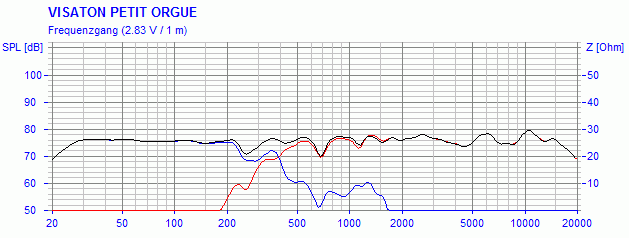
You can see what remains of the resonance response peak from the Ripole's tunnels at about 350-375 Hz. It's not well attenuated, and this is why it appears that the crossover frequency is 400Hz. The peak could have been notched out, at least by 6dB or more, but that would require a more complicated crossover network. I'd give the execution a "meh". ¯\_(ツ)_/¯
Also, notice how the system sensitivity (it's shown for 2.83V input) is pretty darn low? This is another problem with the "Ripole" type constuction: low sensitivity. When using a passive crossover, all you can do is attenuate. To achieve a flat frequency response with extension shown (in the 20s!) you have to compensate for the rising response and in this case that means attenuating away almost 20dB of response by the time you get to 300-400Hz. You are left with the Ripole sensitivity at the low corner, and that is very, very low indeed. It's yet another reason why I prefer large H-frames. They don't have anywhere as much of a sensitivity problem.
PETIT ORGUE | Visaton
It is listed in German under "Technical Data" (you have to click "show all data"):
Trennfrequenz: 300 Hz
Trennfrequenz is translated to "crossover frequency".
Let's look at their frequency response graph for the woofers, shown here:
You can see what remains of the resonance response peak from the Ripole's tunnels at about 350-375 Hz. It's not well attenuated, and this is why it appears that the crossover frequency is 400Hz. The peak could have been notched out, at least by 6dB or more, but that would require a more complicated crossover network. I'd give the execution a "meh". ¯\_(ツ)_/¯
Also, notice how the system sensitivity (it's shown for 2.83V input) is pretty darn low? This is another problem with the "Ripole" type constuction: low sensitivity. When using a passive crossover, all you can do is attenuate. To achieve a flat frequency response with extension shown (in the 20s!) you have to compensate for the rising response and in this case that means attenuating away almost 20dB of response by the time you get to 300-400Hz. You are left with the Ripole sensitivity at the low corner, and that is very, very low indeed. It's yet another reason why I prefer large H-frames. They don't have anywhere as much of a sensitivity problem.
Last edited:
I was just trying to be helpful to eliminate that front facing 18". Unfortunately, these wide open baffles are always eyesore.
LewinskiH01, have you considered removing that 18" completely? If you can run your MTM down to ~150Hz, you can use sub below that. Off course you would need two subs placed right under MTM.
LewinskiH01, have you considered removing that 18" completely? If you can run your MTM down to ~150Hz, you can use sub below that. Off course you would need two subs placed right under MTM.
That 10db null would bug me. Should figure out what's causing it as your Nov measurement of this driver isn't that bad. I'd doubt this is correctable w/DSP .. at least not optimally without effecting overall in room voicing.
It's an 8dB null rather than 10dB and it bugs me too. Here's why I'm thinking it is a mix of driver characteristics and the baffle/MTM:
Here's a simulation with Edge with mic placed as it was during measurement: peaks at 800Hz, while the bottom driver measurement drops after 750Hz and the top driver drops after 700Hz.
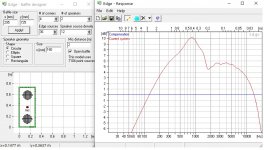
Here are the measurements from top and bottom on baffle, plus naked driver measured in Nov:
Looking at the naked driver measurement, while not readily apparent when looking at that measurement in isolation, when superimposed with the top and bottom driver it appears there is a bit of a drop past 650Hz reaching the lowest point at 780Hz or so.
Hence my hypothesis that the null from top + bottom playing together is likely a combined effect of the baffle and driver characteristics.
Any other effect that could be coming into play? Or way to verify/discard any part of the hypothesis?
I was just trying to be helpful to eliminate that front facing 18". Unfortunately, these wide open baffles are always eyesore.
LewinskiH01, have you considered removing that 18" completely? If you can run your MTM down to ~150Hz, you can use sub below that. Off course you would need two subs placed right under MTM.
I really haven't considered that. Well, sort of: I have two sealed 12" subs that play ok up to about 100Hz or so. The 8PE21 aren't good getting low (they are midranges) so getting to 150Hz in dipole would be challenging. But I'm thinking the naked 18" below the MTM might fly aesthetically and could do 70 to 300Hz. I'm thinking I need a midbass if I'm to keep the 8PE21. So need to decide if these 8" are indeed keepers so I buy another pair to run stereo, or move on to another driver for midrange. I like their mids and high efficiency though.
Sometimes OB woofers are placed at 90 degrees, ie, the edge towards you, it might work, I haven't tried it myself.
On-axis simulated response and in-room LP measured response are two different things. (Sub)woofer's radiation is always more or less reflected and amplified from adjacent wall and floor, but making that show up in measurements if tricky. Wavelet decay and impulse/step response help to find it out. Often reflected bass impulse has higher amplitude and always time lag to direct sound. When measuring a dipole radiatro at 60-120 deg, check impulse in measurement software! REW wants to set time=0 to highest impulse peak, but user can adjust that.
A good example of this is at Atkinson's report of Gradient Helsinki, which hass dipole bass at 90deg to mid/tweeter. Gradient Helsinki 1.5 loudspeaker John Atkinson, November 2010 | Stereophile.com
Gradient Revolution's dipole bass can be rotated... Atkinson's follow-up Gradient Revolution loudspeaker John Atkinson March 1997 | Stereophile.com
A good example of this is at Atkinson's report of Gradient Helsinki, which hass dipole bass at 90deg to mid/tweeter. Gradient Helsinki 1.5 loudspeaker John Atkinson, November 2010 | Stereophile.com
Gradient Revolution's dipole bass can be rotated... Atkinson's follow-up Gradient Revolution loudspeaker John Atkinson March 1997 | Stereophile.com
Last edited:
LewinskiH01 ... your hypothosis about lobing doesn't address the null when they're played individually. Must be something else. Any pictures of the as tested set-up available?
LewinskiH01 ... your hypothosis about lobing doesn't address the null when they're played individually. Must be something else. Any pictures of the as tested set-up available?
I modelled on Edge with the same open baffle, mic always in the same place, and simulated both drivers together (Curve 1), bottom driver only (Curve 2), and top driver only (current system).
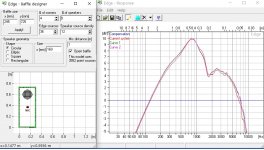
Surprisingly they all display basically the same behavior. They all peak at 800Hz, though, which kind of mimics the null that was measured for both.
I didn't take pictures of the whole setup. I'm attaching the only picture I have, that only gives an idea of placement of drivers vs rotation table...FWIW. The center of the AMT tweeter was 1.6m above ground. I'm wondering if there was a side reflection from the mid-height wall seen on the picture. There are actually two identical walls at both sides 4m away to the left and right. The wall looks higher on the picture than what it actually is...I'm thinking it's lower than 1.6m (where the mic was).
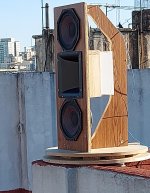
- Home
- Loudspeakers
- Multi-Way
- 3-way open baffle plus subs
